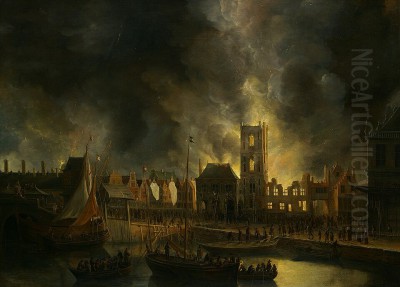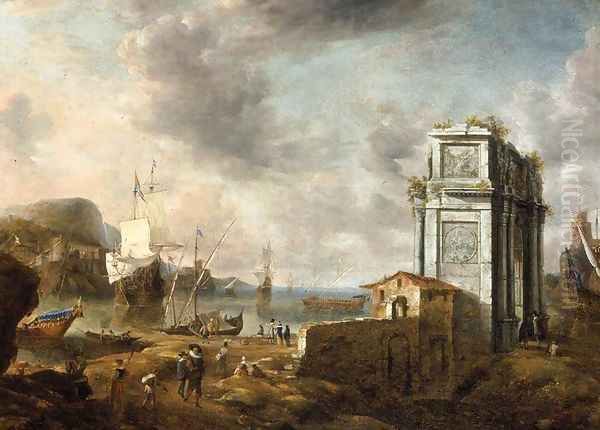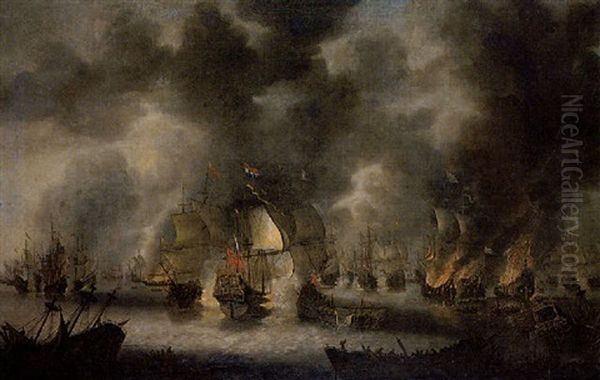
Jan Abrahamsz. Beerstraten (1622–1666) stands as a significant figure within the rich tapestry of Dutch Golden Age painting. Active primarily in Amsterdam, his birthplace and lifelong home, Beerstraten developed a reputation for his evocative and diverse depictions of the world around him. He navigated a range of subjects with remarkable skill, becoming particularly renowned for his atmospheric winter landscapes, dramatic naval battles, bustling harbour scenes, and detailed city views. His work not only captured the visual reality of the 17th-century Netherlands but also infused it with a distinct, often romantic, sensibility, securing his place among the era's most accomplished artists.
Early Life and Family Background
Born in Amsterdam in 1622, Jan Abrahamsz. Beerstraten entered a world brimming with artistic and commercial energy. The Dutch Republic was experiencing its Golden Age, a period of unprecedented economic prosperity, maritime dominance, and cultural flourishing. Amsterdam, as its vibrant heart, was a hub for artists seeking patronage and inspiration. Beerstraten's own family background, however, presents some historical ambiguity, reflecting the challenges often faced when reconstructing the lives of artists from this period based on archival records.
Some sources identify his father as Absalom Beerstraten, described as a cloth merchant. Another prominent account, supported by documents related to his marriage, names his father as Abraham Danielsz. Beerstraten, also a textile worker or merchant, originally from Emden. Yet a third possibility suggests his father might have been Abraham Jansz., a barber-surgeon. This uncertainty highlights the complexities of tracing lineage in 17th-century Amsterdam, where record-keeping, while improving, could still be inconsistent.
More concrete is the information regarding his mother, sometimes identified as Meynsje van den Broekhuyzen, potentially linking the family to Dutch nobility, although this connection requires further substantiation. Regardless of the precise paternal identity, it seems Jan grew up in an environment connected to Amsterdam's commercial life. On August 30, 1642, Jan Abrahamsz. Beerstraten married Magdalena van Bronckhorst (also spelled Brunckhorst) in Amsterdam. Their union was prolific, resulting in eleven children. This large family would become central to Beerstraten's life and, significantly, his artistic legacy, as several sons followed him into the painting profession.

The Beerstraten household appears to have been an artistic one. Jan's eldest son, Johannes Beerstraten, and his second son, Abraham Beerstraten (born c. 1643), both became painters, often working in styles and on subjects closely related to their father's. This familial involvement in the arts would later contribute to considerable confusion regarding the attribution of works signed simply "J. Beerstraten" or variations thereof. The presence of multiple painters within one family, sharing names and subject matter, was not uncommon in the Dutch Golden Age but poses a significant challenge for art historians.
Artistic Development and Influences
Details about Jan Abrahamsz. Beerstraten's formal artistic training remain elusive, a common gap in the biographies of many Dutch masters who were not part of famous workshops like Rembrandt's or Frans Hals'. It is likely he apprenticed with an established master in Amsterdam, learning the fundamentals of drawing, composition, and oil painting techniques prevalent at the time. The city itself, a bustling metropolis filled with canals, distinctive architecture, and a busy port, provided endless subject matter and a competitive artistic market that spurred innovation and specialization.
Beerstraten emerged as an independent master likely in the 1640s. His diverse output suggests a versatile talent, comfortable shifting between the meticulous rendering required for topographical views and the dynamic energy needed for naval battles. He was clearly influenced by the prevailing trends in Dutch art. His winter landscapes, for instance, follow a tradition popularized earlier in the century by artists like Hendrick Avercamp and Esaias van de Velde, who captured the social life and atmospheric conditions of Dutch winters. Beerstraten, however, often brought a softer, more romantic light and mood to these scenes compared to Avercamp's brightly lit, bustling panoramas. Aert van der Neer, another contemporary, specialized in moonlight and winter scenes, offering a different atmospheric perspective.
His seascapes, particularly the naval battles, place him within the esteemed tradition of Dutch marine painting. Artists like Jan Porcellis and Simon de Vlieger had earlier pioneered tonal approaches to depicting the sea and sky. Beerstraten's battle scenes, often depicting specific engagements from the Anglo-Dutch Wars, required not only an understanding of maritime conditions but also a grasp of ship construction and naval tactics, aligning him with specialists like Willem van de Velde the Elder, known for his detailed "pen paintings" of ships and battles, and his son, Willem van de Velde the Younger, who brought dramatic colour and light to marine art. Ludolf Bakhuizen would later continue this tradition with similarly dramatic sea pieces.

Living and working in Amsterdam also placed Beerstraten in proximity to some of the era's greatest talents. Notably, Rembrandt van Rijn was a neighbour for a period. While there's no direct evidence of collaboration or mentorship, the pervasive influence of Rembrandt's dramatic use of light and shadow (chiaroscuro) and his psychological depth might have indirectly informed Beerstraten's approach to atmosphere and composition, particularly in his more evocative or dramatic scenes, like the depiction of the Town Hall fire.
Beerstraten is also known to have collaborated with other artists, a common practice in the period where specialists might contribute figures or specific elements to another's work. Records suggest collaborations with artists such as Abraham Storck, another skilled marine and cityscape painter. Together, they reportedly worked on pieces like the Town Hall of Kampen. Connections with figures like Claes Jansz. Visscher, a prominent printmaker and publisher known for maps and topographical prints, or perhaps more accurately Claes Jansz. van Vleughel (or Vleugel), and Nicolaes Verkolje have also been mentioned, indicating his integration within Amsterdam's active network of artists and artisans.
Subject Matter and Specializations
Jan Abrahamsz. Beerstraten's oeuvre is characterized by its thematic diversity, yet within this range, several key specializations stand out, defining his contribution to Dutch art.
Winter Landscapes
Perhaps Beerstraten's most celebrated works are his winter landscapes. He excelled at capturing the unique atmosphere of Dutch cities and countryside under snow and ice. These scenes often feature prominent architectural landmarks blanketed in white, canals frozen over and teeming with skaters and sleds, under expansive, often leaden-grey skies filled with heavy clouds. Works like The Old Church (Oude Kerk) in Winter (1659, Rijksmuseum, Amsterdam) and The Paalhuis in Winter (Rijksmuseum) exemplify his approach. He masterfully combined topographical accuracy with a romantic sensibility, using soft light and subtle colour variations to convey the crisp air and muted beauty of the season. Unlike the often anecdotal detail filling Avercamp's works, Beerstraten's focus tends towards the overall mood and the interplay of architecture, weather, and human activity.
Seascapes and Naval Battles
Beerstraten was also a highly capable marine painter. His subjects ranged from relatively calm harbour scenes to dramatic depictions of naval warfare. The First Anglo-Dutch War (1652–1654) provided immediate and compelling subject matter. His painting The Battle of Terheide (or Scheveningen), depicting the final battle of that war on August 10, 1653 (Rijksmuseum), is a powerful example. These works showcase his ability to render the complex forms of warships, the dynamic movement of water, and the chaotic energy of battle, often under dramatic skies filled with smoke and cannon fire. He captured the historical significance of these events, which were crucial to the Dutch Republic's identity as a major maritime power. His skill in this genre rivals that of dedicated marine specialists like the Van de Veldes, though perhaps with a slightly less technical focus on ship portraiture and more on the overall dramatic effect.
Cityscapes and Topographical Views
Reflecting a broader interest in topography among the Dutch public in the mid-17th century, Beerstraten produced numerous views of Dutch cities and towns. These often focused on specific buildings or recognisable locations. His depiction of the Ruins of the Old Town Hall of Amsterdam after the Fire of 7 July 1652 (1653, Rijksmuseum) is a striking example of documenting a significant contemporary event. He combined architectural accuracy with a sense of historical moment. He also created more straightforward topographical paintings and possibly drawings, depicting towns such as Edam, Hoorn, Nijmegen, and Monnickendam around the 1650s. These works served not only as artistic representations but also potentially as records used for maps or prints. His approach to cityscapes differs from the meticulously detailed, sunlit clarity of contemporaries like Jan van der Heyden or Gerrit Berckheyde, often favouring more atmospheric conditions, particularly in his winter views.
Mediterranean and Imaginary Ports
Adding another dimension to his work, Beerstraten painted views of Mediterranean ports. Some may have been based on sketches made by other artists who had travelled south, or perhaps on prints, while others appear to be partly or wholly imaginary compositions (capricci). These scenes, such as Mediterranean Harbour (1665), often feature classical ruins, bustling quaysides with exotic figures, and the warm light associated with Southern Europe. This interest aligns him with the "Italianate" painters – Dutch artists like Jan Baptist Weenix or Nicolaes Berchem who travelled to Italy or depicted Italianate landscapes based on secondary sources. These works allowed Beerstraten to explore themes of romanticism, decay, and the allure of distant lands, contrasting with his more familiar Dutch subjects.
Artistic Style and Technique
Jan Abrahamsz. Beerstraten's style is notable for its blend of realism and romanticism. While grounded in the careful observation typical of Dutch Golden Age art, his works often possess a distinct atmospheric quality achieved through his handling of light and colour.
His palette, particularly in winter scenes, tends towards cool, soft tones – whites, greys, blues, and subtle earth colours. He masterfully rendered the effects of light in specific weather conditions, whether it be the diffuse light of an overcast winter day or the dramatic contrasts in a stormy seascape or a fire scene. His skies are often dominant features, setting the mood for the entire composition, frequently depicted with broad, painterly clouds.
Beerstraten paid considerable attention to architectural detail, rendering buildings with accuracy, which was crucial for his topographical views and cityscapes. However, this detail is usually integrated into a broader atmospheric context, preventing the works from becoming mere architectural records. He populated his scenes with small figures – skaters, sailors, townspeople – that add life and scale. These figures are typically rendered with enough detail to be convincing but remain subordinate to the overall landscape or cityscape.
His compositions are generally well-balanced, often using strong diagonal lines (like canals or coastlines) or framing devices (like buildings or ships at the edges) to lead the viewer's eye into the scene. In his naval battles, the composition becomes more dynamic and complex, capturing the chaos and movement of the engagement.
Compared to the crisp, almost photographic detail of Van der Heyden, Beerstraten's brushwork can appear somewhat looser and more painterly, contributing to the softer, more atmospheric feel of many of his works. This blend of topographical interest with a romantic sensibility distinguishes his style within the broader context of 17th-century Dutch landscape painting.
The Beerstraten Family Workshop and Attribution Issues
The name "Beerstraten" presents one of the more complex attribution puzzles in Dutch art history. Jan Abrahamsz. was not the only painter in his family. His sons, Abraham (born c. 1643) and Johannes, also became artists, working in similar genres. Furthermore, another painter named Anthonie Beerstraten (active c. 1637-1664) produced works, particularly winter scenes, that are stylistically close to those of Jan Abrahamsz. Anthonie's exact relationship to Jan Abrahamsz. remains debated – he might have been a brother, cousin, or another relative, or perhaps even unrelated despite the shared name and style. Some earlier sources linked Anthonie to Antwerp, but he primarily seems to have been active in Amsterdam.
This proliferation of Beerstraten painters, often signing their works with variations like "J. Beerstraten," "A. Beerstraten," or "Johannes Beerstraten," has led to significant confusion. Works once confidently attributed to Jan Abrahamsz. have been re-evaluated. For instance, the RKD (Netherlands Institute for Art History) suggests that some works signed "J. Beerstraten," particularly those considered of lesser quality, might actually be by Anthonie. Abraham Beerstraten also specialized in winter scenes and seascapes, making his output difficult to distinguish definitively from his father's, especially since he likely worked in his father's studio initially.
Disentangling the individual contributions of Jan Abrahamsz., Abraham, Johannes, and Anthonie remains an ongoing scholarly task. Generally, works considered to be of the highest quality, displaying the characteristic blend of detailed observation and atmospheric romanticism, are attributed to Jan Abrahamsz. However, the boundaries remain fluid, and the concept of a "Beerstraten workshop," where family members collaborated or produced works under the main master's name, is a likely scenario. This complexity underscores the collaborative and commercial nature of art production in the Dutch Golden Age but complicates the assessment of Jan Abrahamsz.'s individual oeuvre.
Later Life and Second Marriage
Magdalena van Bronckhorst, Jan Abrahamsz. Beerstraten's first wife and mother of his eleven children, passed away sometime before 1665. In April 1665, Beerstraten remarried. His second wife was Albertje Egberts van Crale (or Krael), the widow of Quirijn van den Bosch. This second marriage, however, was short-lived. Jan Abrahamsz. Beerstraten himself died just over a year later.
He passed away in Amsterdam in July 1666, at the relatively young age of 44. He was buried in the Westerkerk, one of Amsterdam's prominent churches, on July 16, 1666. His early death cut short a productive and successful career. He left behind a significant body of work and a family legacy intertwined with his artistic practice. His son Abraham would continue painting in a similar vein for several more decades.
Legacy and Reputation
Despite the attribution challenges surrounding the Beerstraten name, Jan Abrahamsz. Beerstraten is firmly established as one of the important masters of the Dutch Golden Age, particularly noted for his contributions to landscape and marine painting. His legacy is multifaceted.
His works provide invaluable visual records of 17th-century Holland – its cities, harbours, countryside, and significant historical events like naval battles and fires. Paintings like his views of the Oude Kerk, the Paalhuis, or the ruins of the Amsterdam Town Hall capture the specific character of the city during its zenith.
Artistically, his ability to combine topographical accuracy with atmospheric effect and a romantic sensibility was distinctive. His winter scenes, in particular, remain highly admired for their evocative mood and delicate handling of light and colour. They represent a significant development within the Dutch tradition of depicting winter. His naval battles powerfully convey the drama and importance of maritime conflict for the Dutch Republic.
His influence extended through his family, particularly his son Abraham, who continued to produce works in the Beerstraten style. While the overlapping oeuvres create confusion, they also testify to a successful family workshop model.
Today, Jan Abrahamsz. Beerstraten's paintings are held in major museums across the world, including the Rijksmuseum in Amsterdam, the Hamburger Kunsthalle, the Nationalmuseum in Stockholm, the Louvre in Paris, the National Gallery in London, and many others. His works continue to be appreciated by scholars and the public alike for their artistic quality, historical interest, and enduring depiction of the Dutch Golden Age landscape in all its facets – from the frozen stillness of winter to the dynamic chaos of the sea. He remains a testament to the specialization and high level of skill that characterized Dutch painting during this remarkable period.
Conclusion
Jan Abrahamsz. Beerstraten navigated the vibrant art world of 17th-century Amsterdam with considerable success, establishing himself as a master of diverse genres. His evocative winter landscapes, dramatic seascapes, detailed city views, and imaginative harbour scenes showcase a remarkable blend of observational skill and romantic sensibility. While complexities surrounding his family background and the attribution of works within the Beerstraten circle persist, his core achievement remains clear. He captured the essence of the Dutch Golden Age – its landscapes, its maritime power, its urban life, and its historical moments – with a unique atmospheric touch. His paintings continue to resonate, offering compelling glimpses into the past and standing as enduring examples of the richness and variety of Dutch art during its most celebrated era.